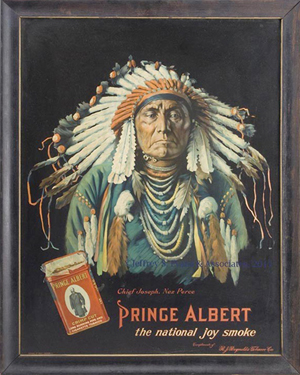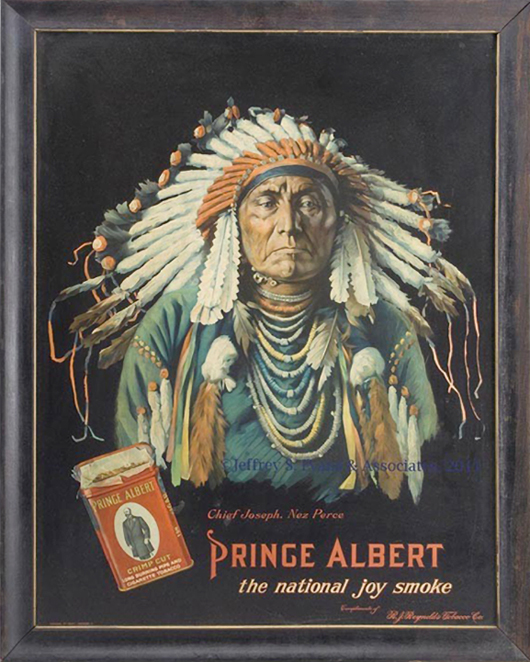
April Fools’ Day is the time for jokes, but so are many other days. Our ancestors enjoyed jokes any day of the year. By the 1850s, potters were making puzzle jugs with holes that let liquid dribble down a shirt front and beer mugs with a ceramic frog or snake inside waiting to appear when the beer was gone. There were bronze figures that came apart to show a different figure inside, and odd ceramic birds that were really bottles with heads that could be removed. One famous American potter made pig-shaped bottles with a saying on the rear that started, “In a hog’s … .” And there were numerous bottles by the German firm Schafer and Vater that were shaped like comic men and women.
The best joke for children of the 1930s involved a tobacco tin. Prince Albert was a very popular brand of tobacco first made in 1907. It was named for the future king of England, Edward VII, who was called “Albert” by his family, and his picture was on the front of the package. It was packaged in a rectangular red tin container with a flip lid. Since many tobaccos were sold in bags, not tins, it was special. The ultimate joke, still quoted today, is a child’s call to a drugstore: “Do you have Prince Albert in a can?” The druggist’s answer, “Yes,” was followed by the young prankster’s response, “Then let him out,” followed by peals of laughter.
The brand also used Chief Joseph, a Nez Perce Indian chief, as an advertising symbol in 1913-14. A large tin sign picturing both the chief and a Prince Albert tobacco tin sold recently for $8,400, proving that Prince Albert tobacco is no joke.
Q: I inherited an old smoking stand. It has a label on the bottom that says, “H.T. Cushman Mfg. Co., Bennington, Vermont.” The stand is 26 inches high and has an ashtray on the top, a pipe holder on each side, a drawer and a small cabinet. Please give me some information about the maker and value.
A: H.T. Cushman Manufacturing Co. was founded by Henry Theodore Cushman in 1889 and remained in business until 1980. It made all sorts of things, from pencil boxes to furniture. The company introduced smoking accessories in the 1910s and continued to make them through the ’20s. Most Cushman smoking stands included a humidor plus storage space for cigar papers, cigar cutters, matches, pipe tobacco and other smoking items. Today, Cushman smoking stands sell for $150 to $300.
Q: I have a pottery pitcher painted gold with a long-tailed orange, blue and green parrot-shaped handle. The impressed die-stamped mark on the bottom of the pitcher is “Camark Pottery” within an outline of the state of Arkansas. Do you know anything about the company? The pitcher is in perfect condition, and I’m wondering what it’s worth.
A: Camark Pottery was the trademark used by Camden Art Tile and Pottery Co. of Camden, Ark. Samuel J. “Jack” Carnes founded the company in 1926. Your parrot-handled pitcher is a well-known Camark specialty design called the Waffle Batter Pitcher. In the 1920s, a New York City retailer had been selling similar pitchers made by an Italian company. When that company could no longer provide the pitchers, the retailer sent a sample to Camark, and Camark started making the pitchers for both the retailer and its own customers. The pitchers were made in a number of different colors and sizes and were produced for several years. The style of mark on your pitcher dates it to 1927-’28. If it’s in great condition, it’s worth $100 or more.
Q: I now own some beautiful cut-glass pieces that belonged to my grandparents. After a recent move, I discovered that one of the bowls had split in half. Is it possible to fix this?
A: It probably is possible, assuming the split is clean and in a cut, not clear, part of the glass. The monetary value of the bowl is lost, but its sentimental value, appearance and use can be saved. If the bowl is large and you’re worried about repairing it yourself, look online for a professional who repairs glass. If you prefer repairing it yourself, prepare a work surface, have toothpicks and some kind of clamping material on hand and buy some clear epoxy glue. Apply the glue carefully, wipe the excess away and clamp the two parts together using masking tape or some other method. You can find detailed instructions online. Once repaired, the bowl can be used to hold fruit, but it may leak if filled with water. Don’t wash it in the dishwasher or put it in the refrigerator. Any change in temperature can cause problems.
Need prices for collectibles? Find them at Kovels.com, our website for collectors. More than 84,000 prices and 5,000 color pictures have just been added. Now you can find more than 900,000 prices that can help you determine the value of your collectible. Access to the prices is free at Kovels.com/priceguide.
Tip: Avoid salt water and chlorine when wearing good jewelry. They can erode metal and dim the shine on stones. Hair spray and perfume also can dull many gemstones.
Terry Kovel answers as many questions as possible through the column. By sending a letter with a question, you give full permission for use in the column or any other Kovel forum. Names, addresses or email addresses will not be published. We cannot guarantee the return of any photograph, but if a stamped envelope is included, we will try. The volume of mail makes personal answers or appraisals impossible. Write to Kovels, Auction Central News, King Features Syndicate, 300 W. 57th St., New York, NY 10019.
CURRENT PRICES
Current prices are recorded from antiques shows, flea markets, sales and auctions throughout the United States. Prices vary in different locations because of local economic conditions.
- Buster Brown yo-yo, tin, image of Buster & Tige on both sides, Japan, 1 x 2 inches, $35.
- Mexicana tablecloth, 12 scenes of Mexico, cotton, 52 x 50 inches, $50.
- Chicken waterer, yellow clay, molded birds, “Manufd. by the W.R. & Co., Akron Ohio, 885,” 6 1/2 inches, $175.
- Coffee grinder, wood, iron and tin, lithographed flags, soldiers and Teddy Roosevelt, Bronson-Walton Co., Cleveland, early 1900s, 10 1/2 inches, $205.
- Weather vane, schooner, copper, three masts, cast-zinc directionals, circa 1900, 52 inches, $300.
- Canteen, wooden, stave construction, bentwood bands, original red and black paint, oblong, American, 19th century, 8 1/2 x 10 inches, $350.
- Sheraton stand, one drawer, walnut, curly maple and poplar, bowed walnut drawer, Ohio, 1820-1840, 29 x 18 3/4 inches, $410.
- Kathe Kruse boy doll, blond hair, brown eyes, jointed legs, red shorts, white shirt, vest, 1950s, 14 inches, $450.
- Georg Jensen cocktail set, sterling silver, Rose pattern, includes bottle opener, cheese scoop, cheese plane, bar knife and caviar spreader with horn blade, original case, $550.
- Van Briggle vase, two bears at top, matte blue to green glaze, marked, 1930s, 15 1/2 inches, $1,770.
Available now. The best book to own if you want to buy, sell or collect – and if you order now, you’ll receive a copy with the author’s autograph. The new Kovels’ Antiques & Collectibles Price Guide, 2012, 44th edition, is your most accurate source for current prices. This large-size paperback has more than 2,500 color photographs and 40,000 up-to-date prices for more than 775 categories of antiques and collectibles. You’ll also find hundreds of factory histories and marks, a report on the record prices of the year, plus helpful sidebars and tips about buying, selling, collecting and preserving your treasures. Available online at Kovelsonlinestore.com; by phone at 800-303-1996; at your bookstore; or send $27.95 plus $4.95 postage to Price Book, Box 22900, Beachwood, OH 44122.
© 2012 by Cowles Syndicate Inc.
ADDITIONAL IMAGE OF NOTE



